Self-Triggered Model Predictive Control of AC Microgrids with Physical and Communication State Constraints
Abstract
:1. Introduction
- (1)
- Due to the limitations of power generation equipment and other hardware facilities (such as transformers, inverters, communication equipment, etc.), the physical state (voltage, frequency, power, etc.) of an AC microgrid is inevitably constrained. Compared with [1,2,3], the proposed algorithm based on the rolling optimization mechanism of MPC can also better solve the problem of physical state constraints on the basis of realizing the above control objectives.
- (2)
- In the problem of optimal active power allocation, the hierarchical control (the third control) is usually used [20,21,22]. However, due to the increase in control times, the control time side will be long, which is not conducive to the rapid recovery and stability of the system. By contrast, the proposed algorithm can achieve the control objectives of both voltage and frequency recovery and optimal active power allocation in the secondary control to avoid the above shortcomings.
- (3)
- In an AC microgrid with a complex communication network, the problem of the excessive communication cost has to be considered. Compared with [28,29,30], we designed the scheme of self-triggered control for the prediction mechanism of the MPC, which avoids the disadvantage of needing to sample at any time for the traditional event triggered and does not require additional design of the observer. Meanwhile, the scheme not only reduces the communication cost and computation burden but also does not have Zeno behavior.
2. Preliminaries
2.1. Communication of AC Microgrids
2.2. Secondary Control of AC Microgrids
2.3. Theory Basics
3. Self-Triggered Model Predictive Control in AC Microgrids
3.1. Self-Triggered Model Predictive Control
3.2. Voltage and Frequency Recovery with Physical State Constraints
3.3. Optimal Active Power Allocation Based on Secondary Control
4. Results
4.1. Stability Analysis
4.2. Elimination of Zeno Behavior
5. Simulations
5.1. Voltage and Frequency Recovery
5.2. Optimal Active Power Allocation
5.3. Triggering Time of the Self-Triggered MPC
6. Conclusions
Author Contributions
Funding
Institutional Review Board Statement
Informed Consent Statement
Data Availability Statement
Conflicts of Interest
References
- Hu, X.; Liu, Z.W.; Wen, G.; Yu, X.; Liu, C. Voltage control for distribution networks via coordinated regulation of active and reactive power of DGs. IEEE Trans. Smart Grid 2020, 11, 4017–4031. [Google Scholar] [CrossRef]
- Wu, Y.-D.; Ge, M.-F.; Liu, Z.-W.; Zhang, W.-Y.; Wei, W. Distributed CPS-Based secondary control of microgrids with optimal power allocation and limited communication. IEEE Trans. Smart Grid 2022, 13, 82–95. [Google Scholar] [CrossRef]
- Patnaik, B.; Mishra, M.; Bansal, R.C.; Jena, R.K. AC microgrid protection a review: Current and future prospective. Appl. Energy 2020, 271, 115210. [Google Scholar] [CrossRef]
- Lai, J.; Lu, X.; Yu, X.; Monti, A. Stochastic distributed secondary control for ac microgrids via event-triggered communication. IEEE Trans. Smart Grid 2020, 11, 2746–2759. [Google Scholar] [CrossRef]
- Li, Y.; Peng, Y.; Wang, X. Seamless switching power sharing control method in a hybrid DC-AC microgrid by the isolated two-stage converter based on SST. IET Power Electron. 2021, 14, 1384–1396. [Google Scholar] [CrossRef]
- Kaushal, J.; Basak, P. Power quality control based on voltage sag swell, unbalancing, frequency, THD and power factor using artificial neural network in PV integrated AC microgrid. Sustain. Energy Grids Netw. 2020, 23, 100365. [Google Scholar] [CrossRef]
- Behera, M.K.; Saikia, L.C. Combined voltage and frequency control for diverse standalone microgrid networks using flexible IDC with novel FOC: A real-time validation. IETE J. Res. 2021, 1–26. [Google Scholar] [CrossRef]
- Rosini, A.; Minetti, M.; Denegri, G.B.; Invernizzi, M. Reactive power sharing analysis in islanded AC microgrids. In Proceedings of the 2019 IEEE International Conference on Environment and Electrical Engineering and 2019 IEEE Industrial and Commercial Power Systems Europe (EEEIC/I&CPS Europe), Genova, Italy, 11–14 June 2019; pp. 1–6. [Google Scholar] [CrossRef]
- Rosini, A.; Bonfiglio, A.; Invernizzi, M.; Procopio, R.; Serra, P. Power management in islanded hybrid diesel-storage microgrids. In Proceedings of the 2019 IEEE PES Innovative Smart Grid Technologies Europe (ISGT-Europe), Bucharest, Romania, 29 September–2 October 2019; pp. 1–5. [Google Scholar] [CrossRef]
- Yuan, W.; Wang, Y.; Liu, D.; Deng, F.; Chen, Z. Efficiency-prioritized droop control strategy of AC microgrid. IEEE J. Emerg. Sel. Top. Power Electron. 2020, 9, 2936–2950. [Google Scholar] [CrossRef]
- Li, D.; Wu, Z.; Zhao, B.; Zhang, L. An improved droop control for balancing state of charge of battery energy storage systems in AC microgrid. IEEE Access 2020, 8, 71917–71929. [Google Scholar] [CrossRef]
- Xiao, H.; Liu, G.; Huang, J.; Hou, S.; Zhu, L. Parameterized and centralized secondary voltage control for autonomous microgrids. Int. J. Electr. Power Energy Syst. 2022, 135, 107531. [Google Scholar] [CrossRef]
- Liu, B.; Wu, T.; Liu, Z.; Liu, J. A small-AC-signal injection-based decentralized secondary frequency control for droop-controlled islanded microgrids. IEEE Trans. Power Electron. 2020, 35, 11634–11651. [Google Scholar] [CrossRef]
- Chen, Y.; Qi, D.; Dong, H.; Li, C.; Li, Z.; Zhang, J. A FDI attack-resilient distributed secondary control strategy for islanded microgrids. IEEE Trans. Smart Grid 2020, 12, 1929–1938. [Google Scholar] [CrossRef]
- Liu, Z.W.; Hu, X.; Ge, M.F.; Wang, Y.W. Asynchronous impulsive control for consensus of second-order multi-agent networks. Commun. Nonlinear Sci. Numer. Simul. 2019, 79, 104892. [Google Scholar] [CrossRef]
- Ge, M.F.; Liu, Z.W.; Wen, G.; Yu, X.; Huang, T. Hierarchical controller-estimator for coordination of networked Euler-CLagrange systems. IEEE Trans. Cybern. 2019, 50, 2450–2461. [Google Scholar] [CrossRef] [PubMed]
- Ge, M.F.; Guan, Z.H.; Yang, C.; Li, T.; Wang, Y.W. Time-varying formation tracking of multiple manipulators via distributed finite-time control. Neurocomputing 2016, 202, 20–26. [Google Scholar] [CrossRef] [Green Version]
- Wang, Z.; Yi, H.; Zhuo, F.; Wu, J.; Zhu, C. Analysis of parameter influence on transient active power circulation among different generation units in microgrid. IEEE Trans. Ind. Electron. 2020, 68, 248–257. [Google Scholar] [CrossRef]
- Roy, N.B.; Das, D. Optimal allocation of active and reactive power of dispatchable distributed generators in a droop controlled islanded microgrid considering renewable generation and load demand uncertainties. Sustain. Energy Grids Netw. 2021, 27, 100482. [Google Scholar] [CrossRef]
- Lu, X.; Xia, S.; Sun, G.; Hu, J.; Zou, W.; Zhou, Q.; Chan, K.W. Hierarchical distributed control approach for multiple on-site DERs coordinated operation in microgrid. Int. J. Electr. Power Energy Syst. 2021, 129, 106864. [Google Scholar] [CrossRef]
- Wu, X.; Xu, Y.; He, J.; Wang, X.; Vasquez, J.C.; Guerrero, J.M. Pinning-based hierarchical and distributed cooperative control for AC microgrid clusters. IEEE Trans. Power Electron. 2020, 35, 9865–9885. [Google Scholar] [CrossRef]
- Vilaisarn, Y.; Moradzadeh, M.; Abdelaziz, M.; Cros, J. An MILP formulation for the optimum operation of AC microgrids with hierarchical control. Int. J. Electr. Power Energy Syst. 2022, 137, 107674. [Google Scholar] [CrossRef]
- Lian, Z.; Deng, C.; Wen, C.; Guo, F.; Lin, P.; Jiang, W. Distributed event-triggered control for frequency restoration and active power allocation in microgrids with varying communication time delays. IEEE Trans. Ind. Electron. 2020, 68, 8367–8378. [Google Scholar] [CrossRef]
- Dehkordi, N.M.; Nekoukar, V. Robust distributed stochastic secondary control of microgrids with system and communication noises. IET Gener. Transm. Distrib. 2020, 14, 1148–1158. [Google Scholar] [CrossRef]
- Hu, J.; Shan, Y.; Guerrero, J.M.; Ioinovici, A.; Chan, K.W.; Rodriguez, J. Model predictive control of microgrids—An overview. Renew. Sustain. Energy Rev. 2021, 136, 110422. [Google Scholar] [CrossRef]
- Chen, T.; Abdel-Rahim, O.; Peng, F.; Wang, H. An improved finite control set-MPC-based power sharing control strategy for islanded AC microgrids. IEEE Access 2020, 8, 52676–52686. [Google Scholar] [CrossRef]
- Batiyah, S.; Sharma, R.; Abdelwahed, S.; Zohrabi, N. An MPC-based power management of standalone DC microgrid with energy storage. Int. J. Electr. Power Energy Syst. 2020, 120, 105949. [Google Scholar] [CrossRef]
- Zheng, C.; Dragičević, T.; Blaabjerg, F. Model predictive control-based virtual inertia emulator for an islanded alternating current microgrid. IEEE Trans. Ind. Electron. 2020, 68, 7167–7177. [Google Scholar] [CrossRef]
- Blanco, A.; Labella, D.; Mestriner, D.; Rosini, A. Model predictive control for primary regulation of islanded microgrids. In Proceedings of the 2018 IEEE International Conference on Environment and Electrical Engineering and 2018 IEEE Industrial and Commercial Power Systems Europe (EEEIC/I&CPS Europe), Palermo, Italy, 12–15 June 2018; pp. 1–6. [Google Scholar] [CrossRef]
- Rosini, A.; Mestriner, D.; Labella, A.; Bonfiglio, A.; Procopio, R. A decentralized approach for frequency and voltage regulation in islanded PV-Storage microgrids. Electr. Power Syst. Res. 2021, 193, 106974. [Google Scholar] [CrossRef]
- Gan, L.K.; Zhang, P.; Lee, J.; Osborne, M.A.; Howey, D.A. Data-driven energy management system with Gaussian process forecasting and MPC for interconnected microgrids. IEEE Trans. Sustain. Energy 2020, 12, 695–704. [Google Scholar] [CrossRef]
- Xu, J.Z.; Ge, M.F.; Liu, Z.W.; Zhang, W.Y.; Wei, W. Force-reflecting hierarchical approach for human-aided teleoperation of NRS with event-triggered local communication. IEEE Trans. Ind. Electron. 2022, 69, 2843–2854. [Google Scholar] [CrossRef]
- Wang, L.; Ge, M.F.; Zeng, Z.; Hu, J. Finite-time robust consensus of nonlinear disturbed multiagent systems via two-layer event-triggered control. Inf. Sci. 2018, 466, 270–283. [Google Scholar] [CrossRef]
- Wan, X.; Tian, Y.; Wu, J.; Ding, X.; Tu, H. Distributed event-triggered secondary recovery control for islanded microgrids. Electronics 2021, 10, 1749. [Google Scholar] [CrossRef]
- Xu, G.; Ma, L. Resilient self-triggered control for voltage restoration and reactive power sharing in islanded microgrids under Denial-of-Service attacks. Appl. Sci. 2020, 10, 3780. [Google Scholar] [CrossRef]
- Pogaku, N.; Prodanovic, M.; Green, T.C. Modeling, analysis and testing of autonomous operation of an inverter-based microgrid. IEEE Trans. Power Electron. 2007, 22, 613–625. [Google Scholar] [CrossRef] [Green Version]
- Bidram, A.; Davoudi, A.; Lewis, F.L.; Qu, Z. Secondary control of microgrids based on distributed cooperative control of multi-agent systems. IET Gener. Transm. Distrib. 2013, 7, 822–831. [Google Scholar] [CrossRef] [Green Version]
- Milošević, M. Convergence and almost sure polynomial stability of the backward and forward-backward Euler methods for highly nonlinear pantograph stochastic differential equations. Math. Comput. Simul. 2018, 150, 25–48. [Google Scholar] [CrossRef]
- Duan, J.; Zhang, H.; Wang, Y.; Han, J. Output consensus of heterogeneous linear MASs by self-triggered MPC scheme. Neurocomputing 2018, 315, 476–485. [Google Scholar] [CrossRef]
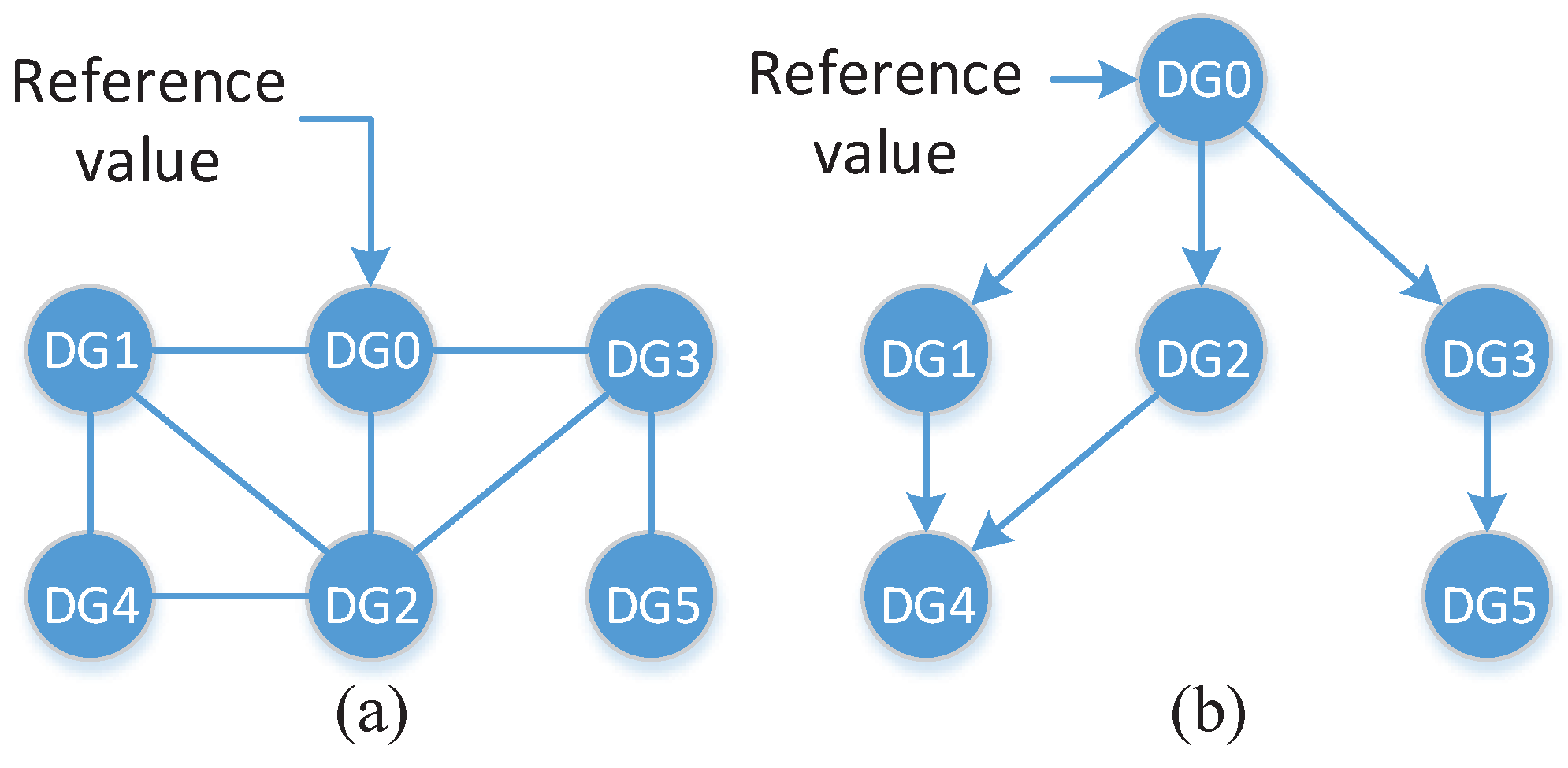
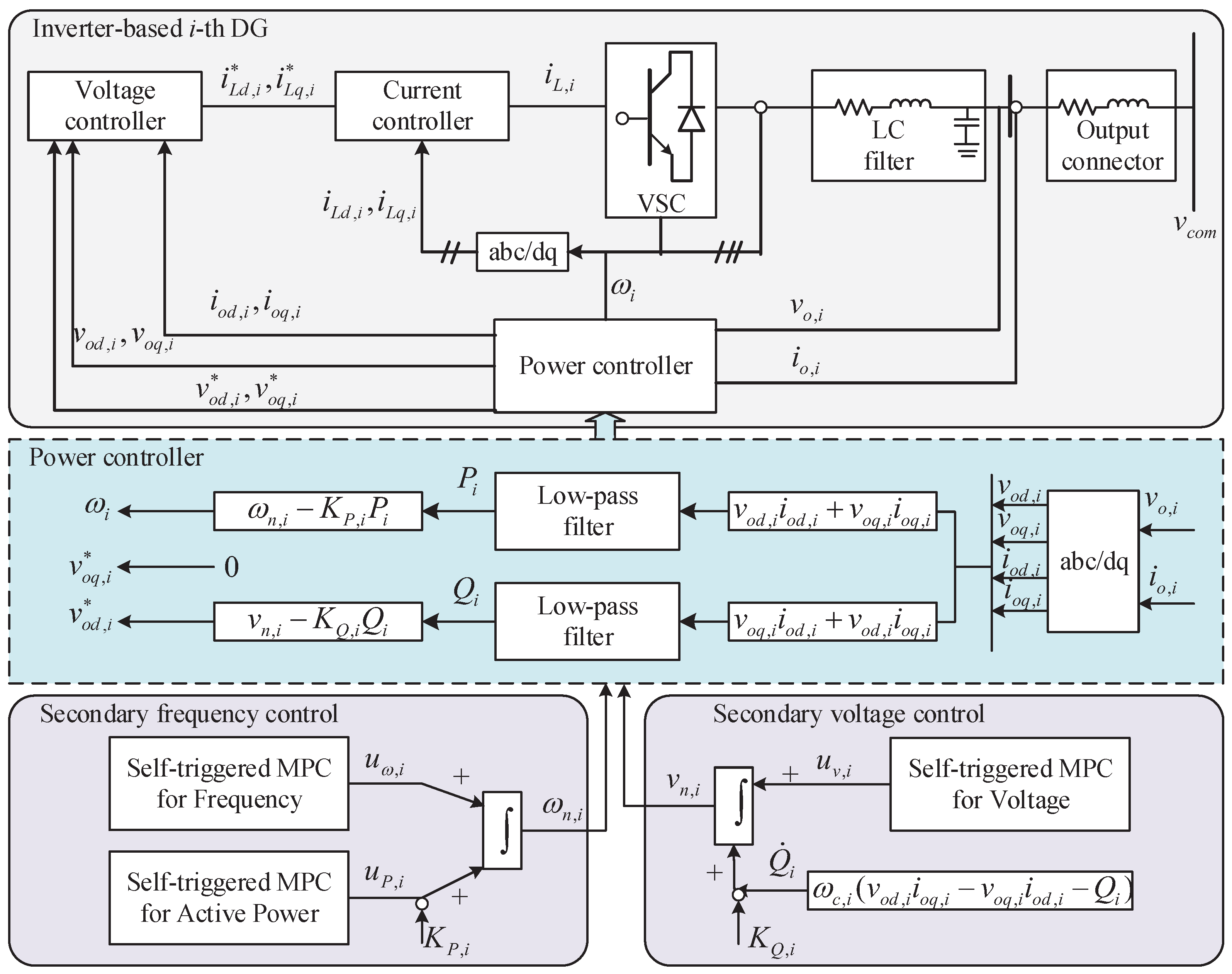
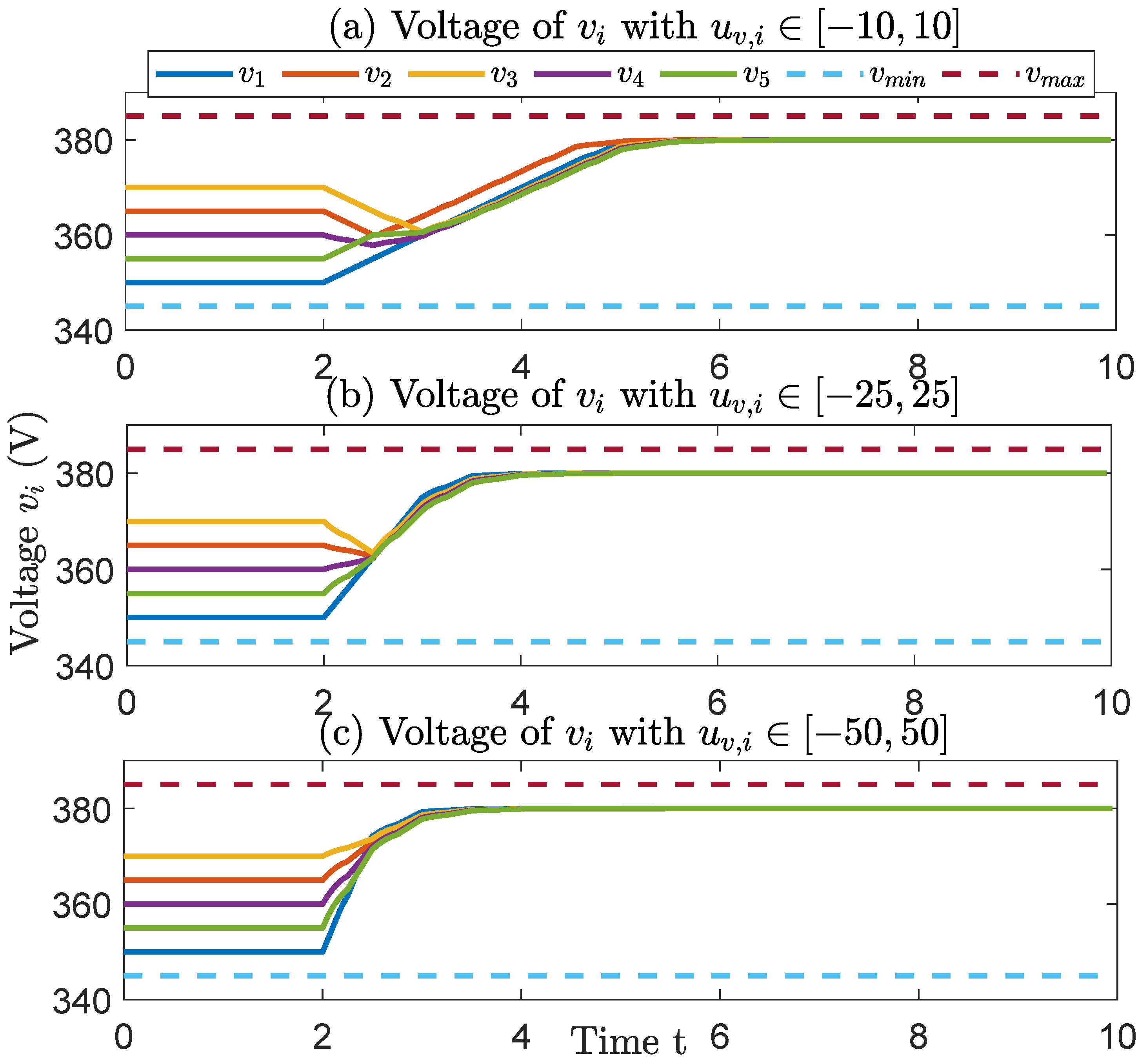

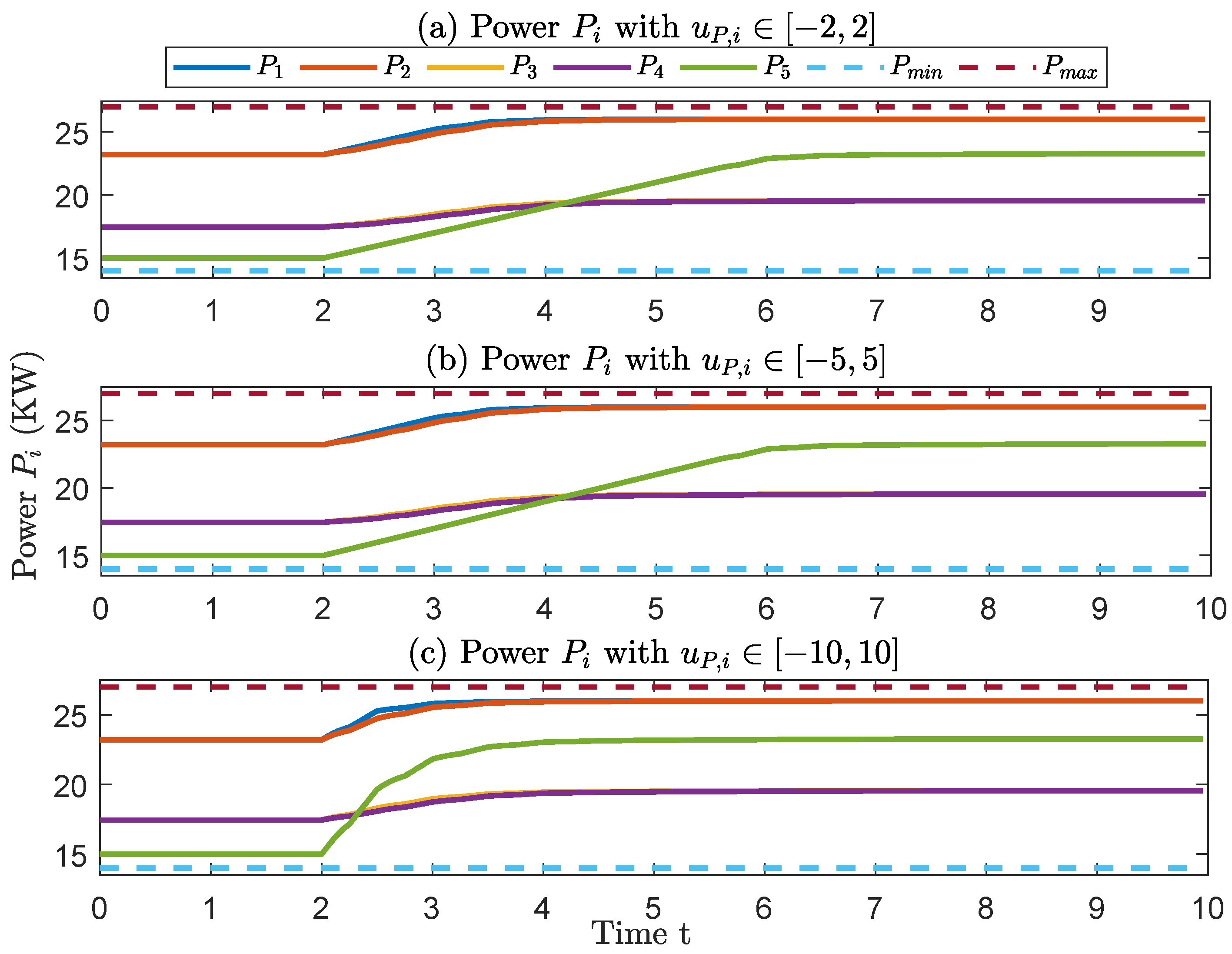
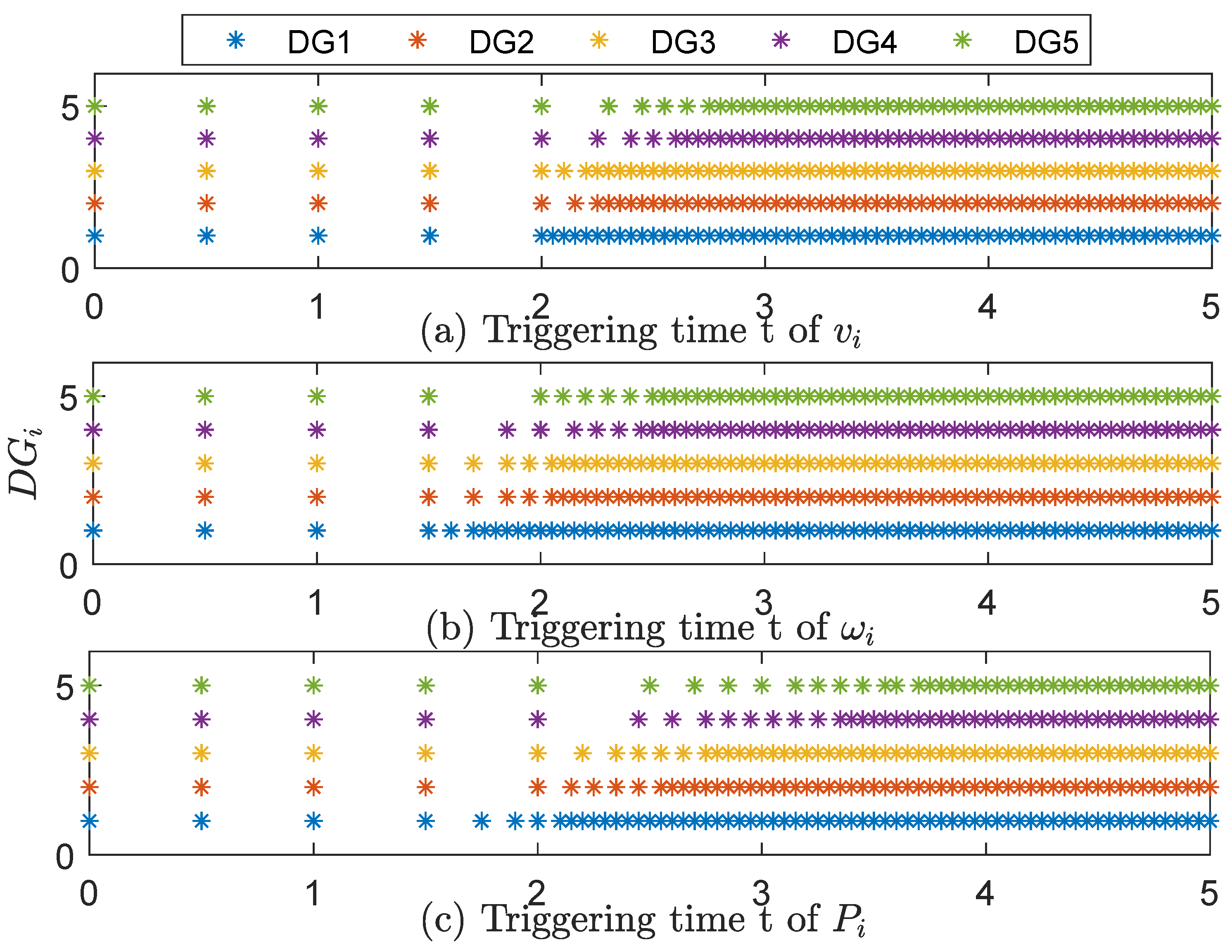
| Parameter | |||||
|---|---|---|---|---|---|
| = 0.35 mH | = 0.03 | = 0.1 mH | = 1.35 mH | = 0.1 mH | = 50 F |
| Parameter | Load 1 | Load 2 | |||
| (per phase) | 12 kW | 15.3 kW | |||
| (per phase) | 12 kVAr | 7.6 kVAr | |||
| Parameter | Line 1 | Line 2 | Line 3 | ||
| 0.23 | 0.35 | 0.23 | |||
| 318 H | 1847 H | 318 H |
| Parameter | |||||
|---|---|---|---|---|---|
| 0.75 | 0.5 | 0.7 | 0.6 | 0.8 | |
| T = 0.05 s | K = 2 | = 10 | |||
| Parameter of | Q = 10 | R = 1 | = 380 V | ||
| Parameter of | Q = 15 | R = 2 | = 314 (rad/s) | ||
| Parameter of | Q = 6 | R = 1 | = 26 kW |
Publisher’s Note: MDPI stays neutral with regard to jurisdictional claims in published maps and institutional affiliations. |
© 2022 by the authors. Licensee MDPI, Basel, Switzerland. This article is an open access article distributed under the terms and conditions of the Creative Commons Attribution (CC BY) license (https://creativecommons.org/licenses/by/4.0/).
Share and Cite
Dong, X.; Gan, J.; Wu, H.; Deng, C.; Liu, S.; Song, C. Self-Triggered Model Predictive Control of AC Microgrids with Physical and Communication State Constraints. Energies 2022, 15, 1170. https://doi.org/10.3390/en15031170
Dong X, Gan J, Wu H, Deng C, Liu S, Song C. Self-Triggered Model Predictive Control of AC Microgrids with Physical and Communication State Constraints. Energies. 2022; 15(3):1170. https://doi.org/10.3390/en15031170
Chicago/Turabian StyleDong, Xiaogang, Jinqiang Gan, Hao Wu, Changchang Deng, Sisheng Liu, and Chaolong Song. 2022. "Self-Triggered Model Predictive Control of AC Microgrids with Physical and Communication State Constraints" Energies 15, no. 3: 1170. https://doi.org/10.3390/en15031170






